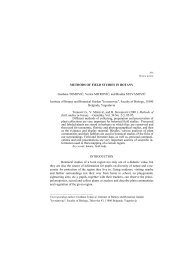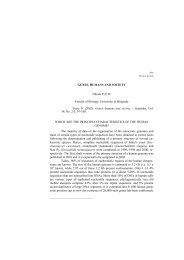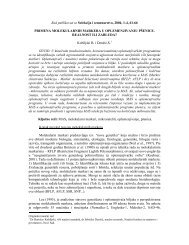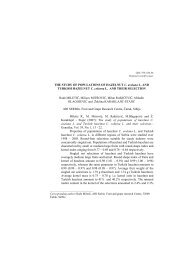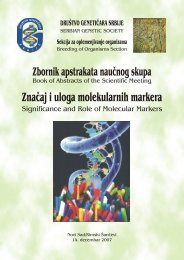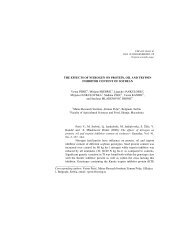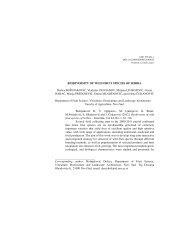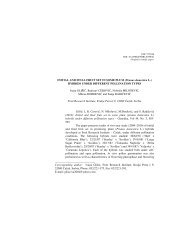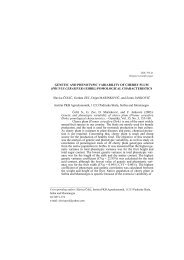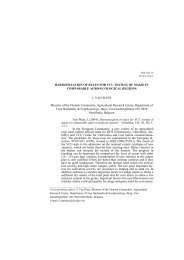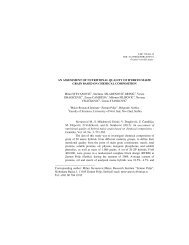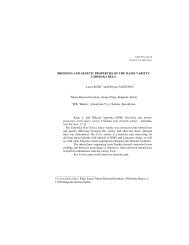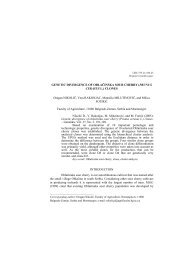Zbornik - Društvo genetičara Srbije
Zbornik - Društvo genetičara Srbije
Zbornik - Društvo genetičara Srbije
You also want an ePaper? Increase the reach of your titles
YUMPU automatically turns print PDFs into web optimized ePapers that Google loves.
IV-Usm-22 ZBORNIK ABSTRAKATA III KONGRESA GENETIÈARA SRBIJE 111<br />
Subotica, 30. novembar - 4. decembar 2004.<br />
MORFO-ANATOMSKA SVOJSTVA ÈETINA SPONTANIH MUTANATA<br />
BELOG BORA (Pinus silvestris L.) SA UTIM ÈETINAMA<br />
Dragica Vilotiæ 1 , M. Tošiæ 2 i Gordana Radoševiæ 1<br />
1<br />
Šumarski fakultet, Beograd<br />
2<br />
Dimitrija Tucoviæa 41, Uice<br />
Borovi kod kojih je uta boja uslovljena genetskom konstitucijom, poznati su kao «zlatni<br />
borovi» i odavno su predmet interesovanja, posebno struènjaka za pejzanu arhitekturu.<br />
U radu su prikazani uporedni rezultati morfoloških i anatomskih svojstava dvogodišnjih<br />
èetina tri stabla belog bora sa utim èetinama na Zlatiboru: P.silvestris L. var. zlatibirica<br />
Omanoviæ (1937), P. silvestris L. var. aurea zlatiborensis Tošiæ (1995) i novootkrivenog<br />
stabla sa osobinama himere (Tošiæ M. 2002) koje ima posebne grane sa zelenim, sa<br />
izrazito utim i sa uto-zelenim (panaširanim) èetinama, kada je jedna strana èetine<br />
zelena, a druga uta po celoj svojoj duini. Analizirani su: velièina, brojnost i boja èetina,<br />
kao i: broj slojeva hipodermalnih æelija i broj njihovih grupacija, slojevi sklerenhimskih<br />
æelija u zoni sprovodnih snopiæa i broj smolnih kanala. Èetine prouèavanih mutanata<br />
bitno se razlikuju po svojim morfološkim osobinama i anatomskoj graði, kako od<br />
tipiènog varijeteta belog bora, tako i meðusobno. Prouèavanje spontanih mutanata<br />
šumskog drveæa, kao i ovih «zlatnih borova» zasluuje punu panju, jer su prirodne<br />
retkosti sa specifiènim osobinama, koje ih èine atraktivnim za korišæenje u hortikulturi.<br />
U cilju trajnog oèuvanja i proizvodnje ukrasnih kultivara, njihovi genotipovi su fiksirani<br />
heterovegetativnim razmnoavanjem.<br />
MORPHO-ANATOMIC PROPERTIES OF THE NEEDLES OF SCOTS PINE<br />
(Pinus silvestris L.) SPONTANEOUS MUTANTS WITH YELLOW NEEDLES<br />
The pines in which yellow colour is conditioned by genetic constitution, are known as<br />
«golden pines» and they have been subjects of interest, especially of landscape architects,<br />
for a long time. This paper presents the comparative results of morphological and anatomical<br />
characters of second-year needles of three Scots pines with yellow needles on<br />
Mt. Zlatibor: P. silvestris L. var. zlatibirica Omanoviæ (1937), P. silvestris L. var. aurea<br />
zlatiborensis Tošiæ (1995) and the newly discovered tree with chimera characteristics<br />
(Tošiæ M., 2002), with individual branches with green, with explicitly yellow and with<br />
yellow-green needles, when one side of the needle is green, and the other yellow, along<br />
the whole length. The analysed characters are: needle size, number and colour, number of<br />
layers of hypodermic cells and number of their groups, layers of sclerenchymous cells in<br />
the vascular bundle zone and the number of resin channels. The needles of the study mutants<br />
differ essentially by their morphological characters and anatomic structure, both<br />
from the typical Scots pine variety, and among themselves. The study of spontaneous<br />
mutants of forest trees, and also these «golden pines» deserves full attention, because<br />
they are natural rarities with specific characteristics, which make them attractive for amenity<br />
horticulture. In the aim of permanent conservation and production of ornamental<br />
cultivars, their genotypes have been fixed by heterovegetative reproduction.



